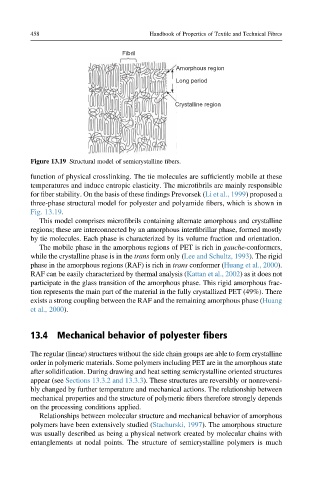Page 485 - Handbook of Properties of Textile and Technical Fibres
P. 485
458 Handbook of Properties of Textile and Technical Fibres
Fibril
Amorphous region
Long period
Crystalline region
Figure 13.19 Structural model of semicrystalline fibers.
function of physical crosslinking. The tie molecules are sufficiently mobile at these
temperatures and induce entropic elasticity. The microfibrils are mainly responsible
for fiber stability. On the basis of these findings Prevorsek (Li et al., 1999) proposed a
three-phase structural model for polyester and polyamide fibers, which is shown in
Fig. 13.19.
This model comprises microfibrils containing alternate amorphous and crystalline
regions; these are interconnected by an amorphous interfibrillar phase, formed mostly
by tie molecules. Each phase is characterized by its volume fraction and orientation.
The mobile phase in the amorphous regions of PET is rich in gauche-conformers,
while the crystalline phase is in the trans form only (Lee and Schultz, 1993). The rigid
phase in the amorphous regions (RAF) is rich in trans conformer (Huang et al., 2000).
RAF can be easily characterized by thermal analysis (Kattan et al., 2002) as it does not
participate in the glass transition of the amorphous phase. This rigid amorphous frac-
tion represents the main part of the material in the fully crystallized PET (49%). There
exists a strong coupling between the RAF and the remaining amorphous phase (Huang
et al., 2000).
13.4 Mechanical behavior of polyester fibers
The regular (linear) structures without the side chain groups are able to form crystalline
order in polymeric materials. Some polymers including PET are in the amorphous state
after solidification. During drawing and heat setting semicrystalline oriented structures
appear (see Sections 13.3.2 and 13.3.3). These structures are reversibly or nonreversi-
bly changed by further temperature and mechanical actions. The relationship between
mechanical properties and the structure of polymeric fibers therefore strongly depends
on the processing conditions applied.
Relationships between molecular structure and mechanical behavior of amorphous
polymers have been extensively studied (Stachurski, 1997). The amorphous structure
was usually described as being a physical network created by molecular chains with
entanglements at nodal points. The structure of semicrystalline polymers is much

